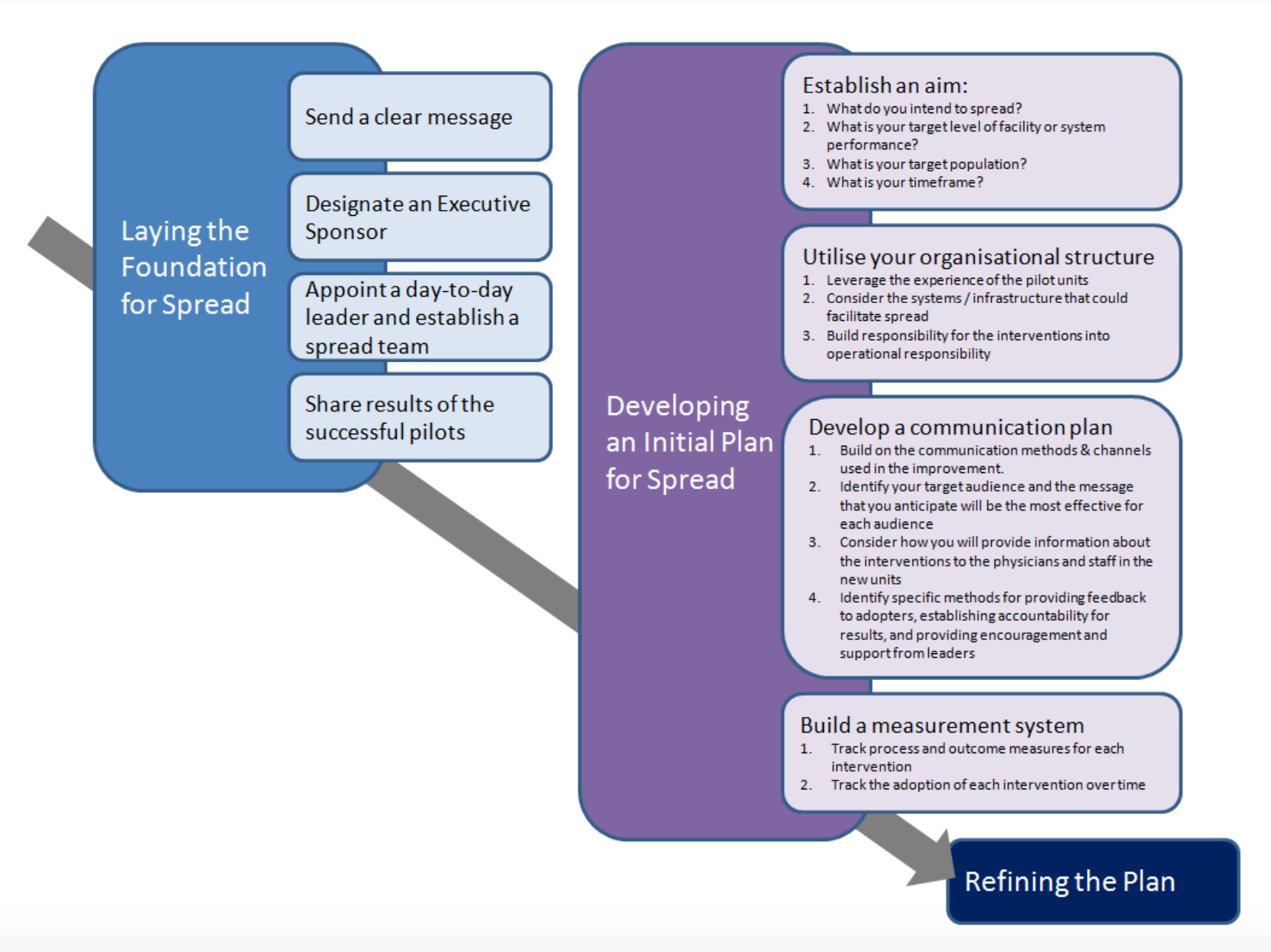Start improving with Life QI today
Full access to all Life QI features and a support team excited to help you. Quality improvement has never been easier.

Organisation already using Life QI?
Sign-up

In this article we’re going to look at various elements of your spread plan for Quality Improvement (QI) including establishing an aim for spread, as well as developing and executing your spread plan.
If you’ve already assessed and approved the readiness of the spread of your QI project, it’s time to develop your Spread Plan.
A really good place to start might be the NHS Institute for Innovation and Improvement Spread and Adoption tool. It guides you through QI readiness, and helps you to assess people and leadership, innovation and benefits, context and infrastructures.
When you are looking at establishing an ‘aim’ for spread - in order to encourage spread and adoption of improvement - you could think about creating an ‘aim statement’, which will distil what you are aiming for with your QI project. As the Institute of Healthcare Improvement (IHI) describes an aim statement as: ‘the answer to the first question in the Model for Improvement, ‘What are we trying to accomplish?
In their report ‘Framework for Spread’ the IHI highlight the importance of spread planning, in addressing the “who, what, and where” of spread. They advise that spread should include consideration of the following elements:
We go into more details about how you can create your own aim statement in our blog. So, we would recommend taking a look at this to give you more guidance.
The IHI have created a Framework for Spread which can help you kick off the development of your spread plan. It helps bridge the gap ‘between best practice and common practice’ and supports you to rapidly spread innovations. The IHI cite organisations who have used elements of the Framework for Spread to plan and guide their spread activities.
In this report, the IHI drill down into more detail about how to develop your Spread Plan. They encourage you to ask the following questions:
East London NHS Foundation Trust (ELFT) have a very active QI programme. They have put together a useful document which you can download and complete to help you develop a spread plan. The plan helps you assess, set out and think about how the spread of the QI project aligns with priorities from your organisation or trust. It goes into detail about resourcing and structure, and encourages you to think about who you want to work with.
Healthcare Improvement Scotland’s ‘Guide on spread and sustainability’ also gives guidance about how you can develop a spread plan. It highlights the need for creating a spread team and establishing executive buy-in and sponsorship. The guide helps you map out communications plans to support spread and raise profile of your QI work. The authors set out how to create consistent messages for your target audiences and give examples of work carried out at different trusts. They have also created an extremely helpful visual drawn from the IHI’s Spread plan, which you might find useful.

Figure 1: Figure created to visually summarise the 100,000 Lives Campaign
How-to Guide: Sustainability and Spread
So, you’ve drafted your spread plan and shared it with your team. Now it’s time to start the spread and adoption of improvement! As part of your initial plan has been to look at ways to attract early adopters and identify where you need to make changes in the infrastructure, you should be ready to get going.
In the article 'Using a Framework for Spread: The Case of Patient Access in the Veterans Health Administration' the writers look in great detail at one of the key elements to the success of a spread plan: communications - and getting your spread team on board. If you have laid these foundations, you will find this process easier. They recommend: 'Because communication is at the heart of spread, the day-to-day manager of a spread initiative needs to organise a communication campaign'. These communications can be via a mix of communications channels and should raise awareness of the project. The authors also recommend that technical knowledge is best communicated via colleagues. These people may be opinion leaders and who will be able to convey these complex messages in person.
Another important element in ensuring the success of your spread plans is put in place methods for getting feedback on how your spread plan is working. This can be in the form of informal reports from sites you are targeting. It is also really important to encourage ongoing communication between QI experts and people implementing these changes, enabling and encouraging people on the ground to make adjustments when necessary.
As part of your 'checklist for Spread' you will be looking at how you will measure your outcomes, and you will identify who will be responsible for collecting the data. Life QI can be really useful here, as it supports you in the spread and adoption of improvement. This solution enables you to gather data and monitor all information in one place and share ideas and project updates.
The IHI actively encourages QI teams to help share and identify spread strategies across different organisations, to help guide improvements across the health system, thus: 'We encourage organizations to apply the elements of the Framework for Spread, and to share their insights with IHI as to which activities contribute to the successful spread of innovative ideas in health care. This continues to be a pressing need for the continued improvement of health care, nationally as well as internationally.'
To conclude: In the words of the Health Foundation's paper 'The spread challenge: How to support the successful uptake of innovations and improvements in health care', ‘Health care improvement is not only about finding innovative solutions to the challenges facing the health service, but also how to ensure these solutions are taken up successfully across the NHS.’ Challenging traditional ways of thinking, the report argues that programmes to spread innovation and improvement should support those adopting an idea developed elsewhere, as well as innovators.
Good luck with developing your spread plan and spreading your QI ideas!
Full access to all Life QI features and a support team excited to help you. Quality improvement has never been easier.

Organisation already using Life QI?
Sign-up


.png)


